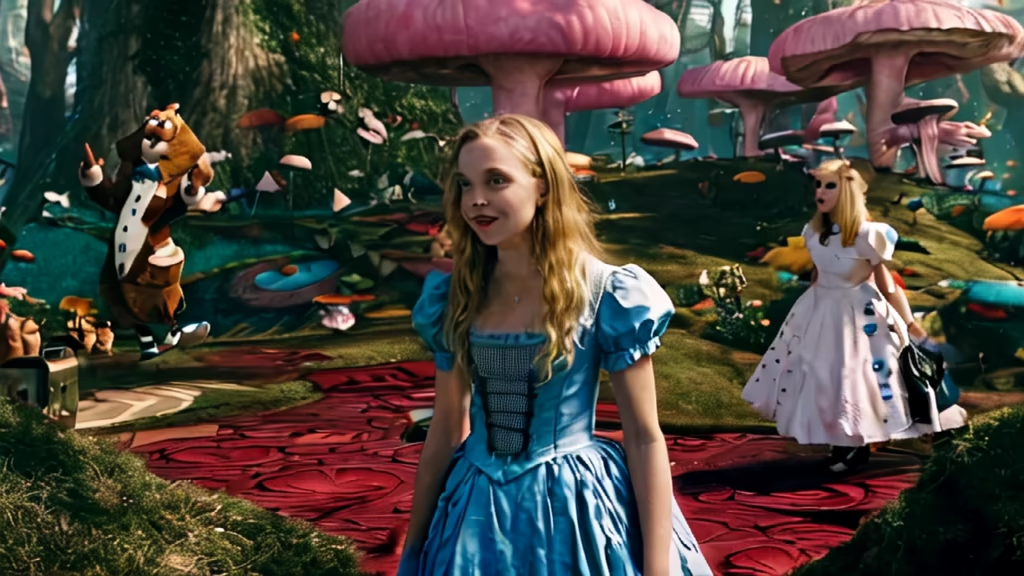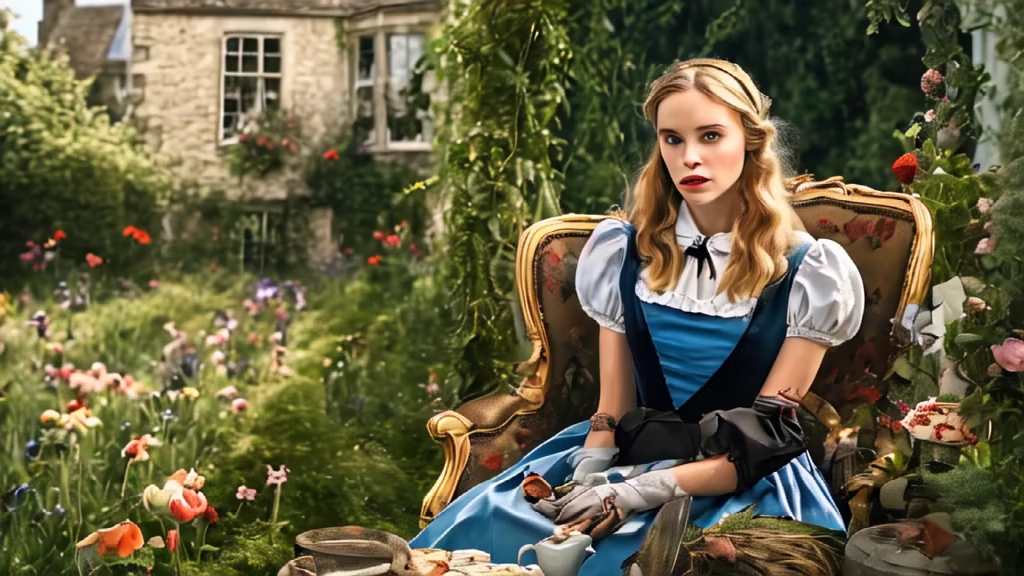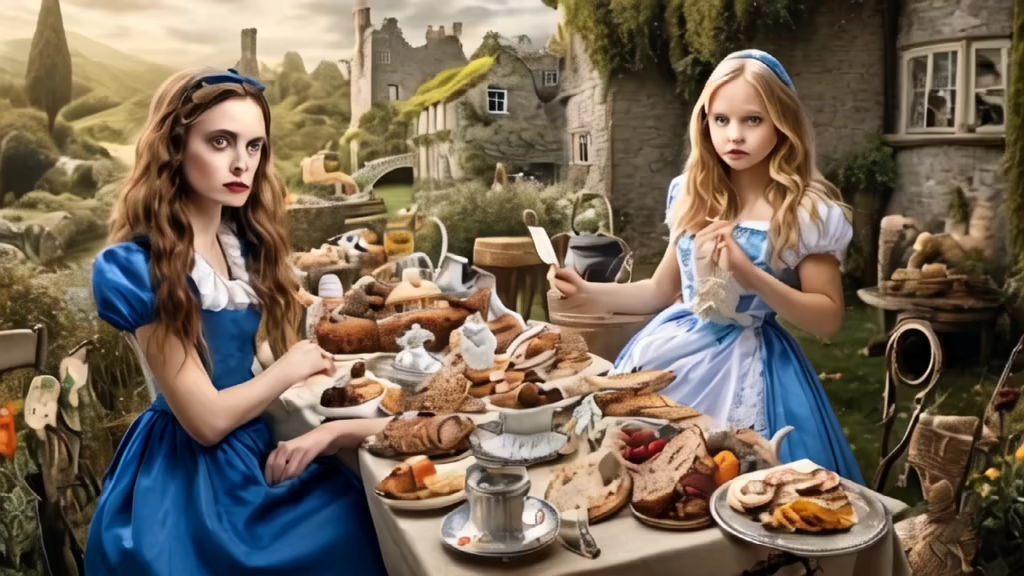Prompt: In Through the Looking-Glass, a narrative loosely governed both by specular principles and by the rules of chess, once again Alice isn’t at all recalcitrant to play the game – in fact, by her own admission, she “would like to be a Queen, best”. Isn’t this tantamount to a declaration of willingness, nay, eagerness to develop? And so we come back to my original point.






Prompt: Besides, Alice is mostly in charge of her metamorphoses. Granted: we have to allow for a certain margin of error, but that’s only fair. In Wonderland, precise instructions are pretty thin on the ground beyond a cursory “Drink Me” or “Eat Me”. Not to mention Caterpillar’s cryptic advice about the “two sides” of the mushroom he’s sitting on: one makes you grow taller, the other shorter but, to Alice’s puzzlement, “which is which?”.






Prompt: It’s true that the changes in Alice’s body, and her confusion about her own identity, lend themselves to being read as apt correlatives to the turmoil of puberty. But, forgive my literal-mindedness, the seven-(and-a-half)-year-old Alice would have to be a really precocious child to worry about puberty or adulthood – even at a time when the age of consent was twelve.


Prompt: As for Alice, in the garden of live flowers, she is told flat out that she is “beginning to fade” – a point reiterated in a roundabout way in Humpty Dumpty’s suggestion that she “might have left off at seven”, instead of reaching the “uncomfortable”, grand old age of “seven years and six months”.


Prompt: Intimations of our transience become more insistent – they would, wouldn’t they? – in Through the Looking-Glass, the sequel Carroll published in December 1871. The prefatory poem to this winter narrative has a distinctly melancholy tone, spelling out the exact cause for such a change in mood: “We are but older children, dear, / who fret to find our bedtime near.”






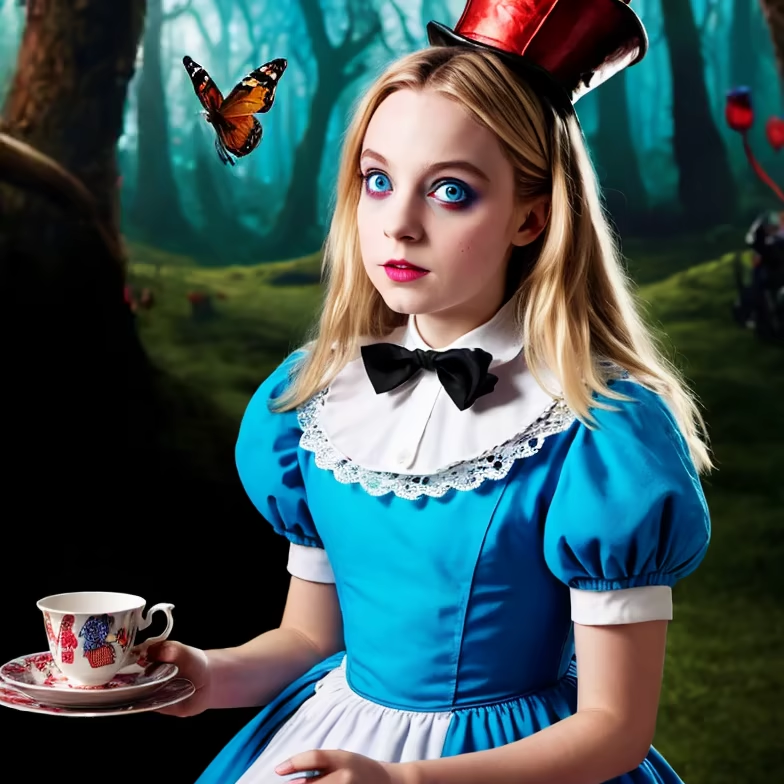
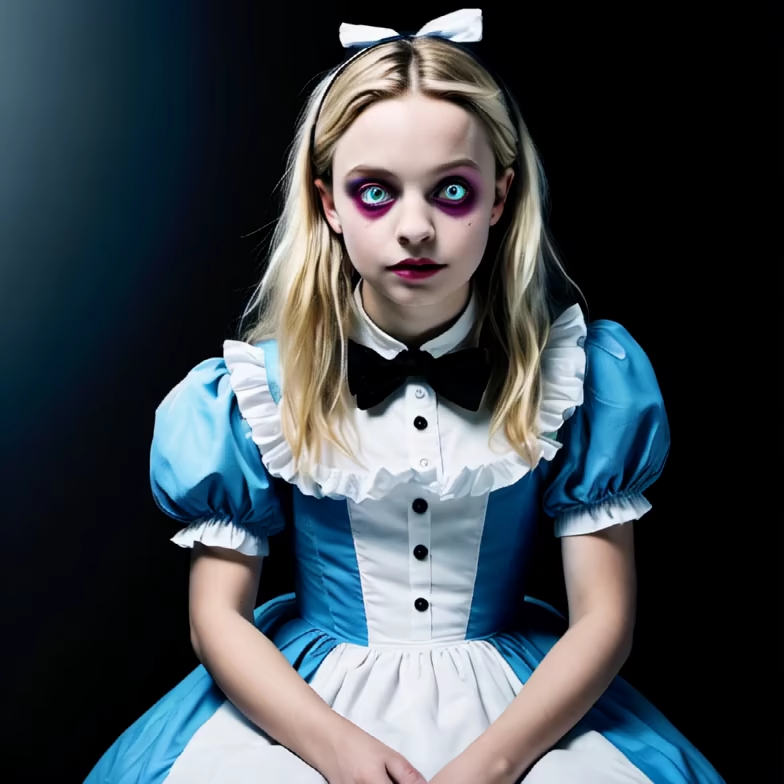
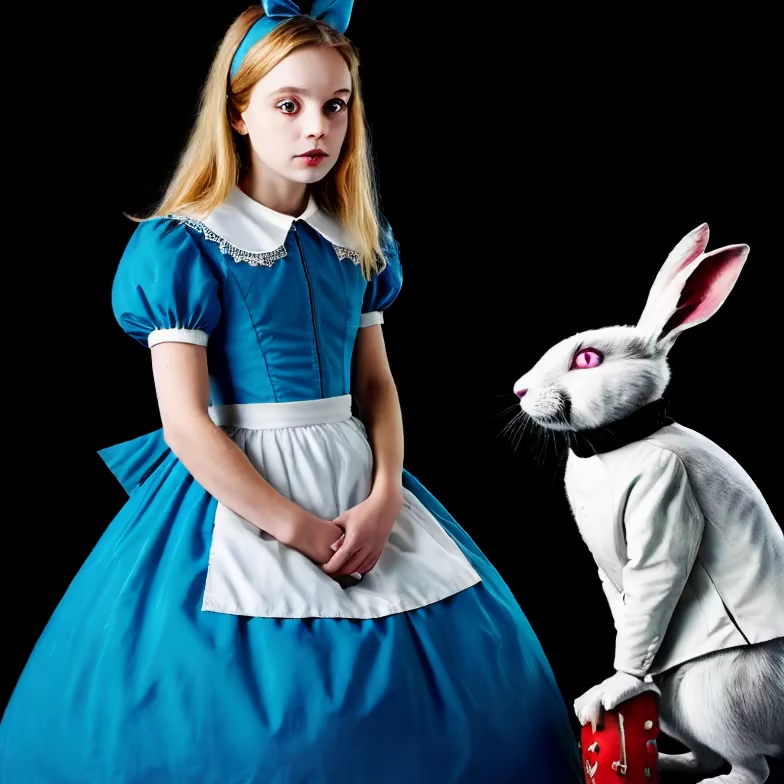
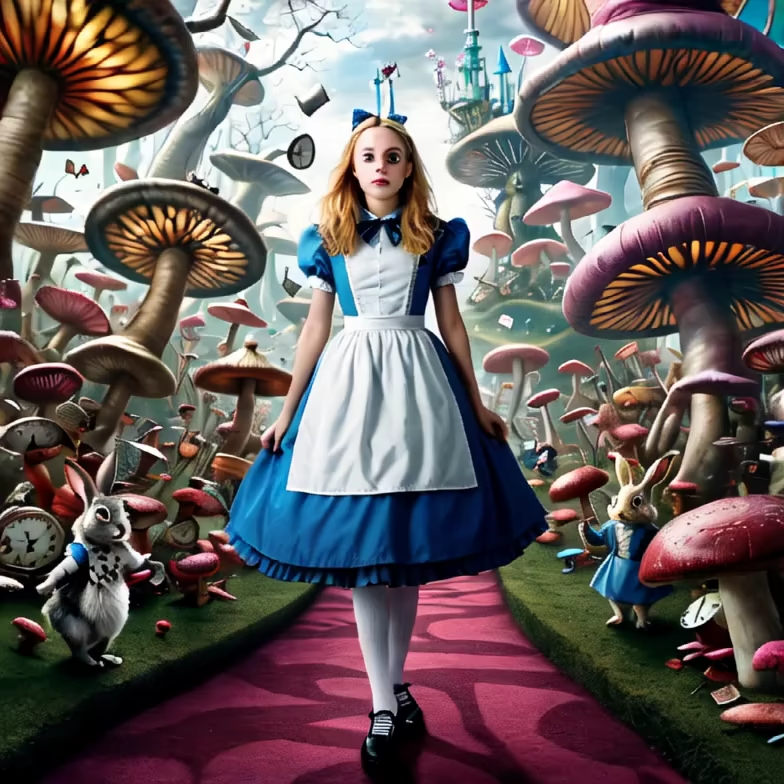
Prompt: Alice, a young girl, sits bored by a riverbank and spots a White Rabbit with a pocket watch and waistcoat lamenting that he is late. Surprised, Alice follows him down a rabbit hole, which sends her into a lengthy plummet but to a safe landing. Inside a room with a table, she finds a key to a tiny door, beyond which is a garden. While pondering how to fit through the door, she discovers a bottle reading \"Drink me\". Alice drinks a portion of the bottle's contents, and to her astonishment, she shrinks small enough to enter the door. However, she had left the key upon the table and cannot reach it. Alice then discovers and eats a cake, which causes her to grow to a tremendous size. Unhappy, Alice bursts into tears, and the passing White Rabbit flees in a panic, dropping a fan and two gloves. Alice uses the fan for herself, which causes her to shrink once more and leaves her swimming in a pool of her own tears. Within the pool, Alice meets various animals and birds, who convene on a bank and engage in a \"Caucus Race\" to dry themselves. Following the end of the race, Alice inadvertently frightens the animals away by discussing her cat.

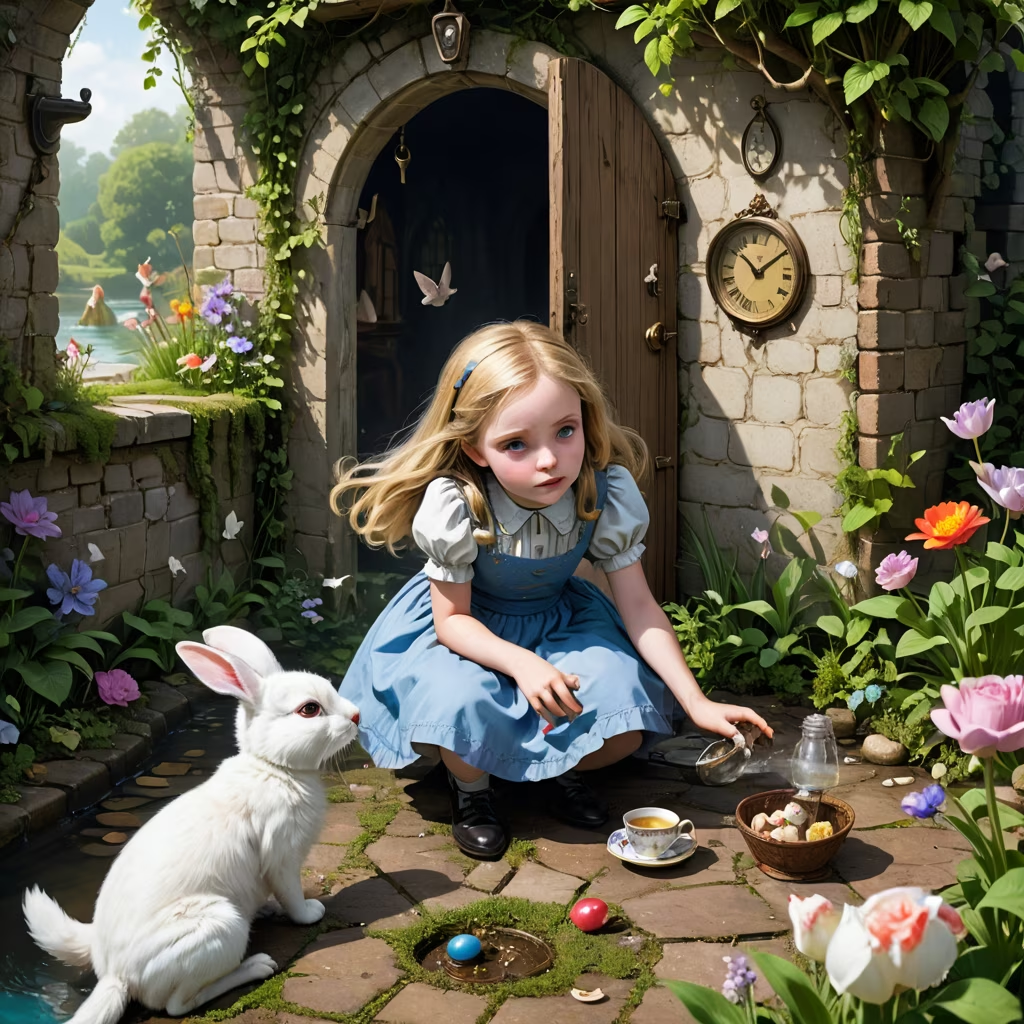


Prompt: Her problem-solving skills are further taxed by the fact that the mushroom is “perfectly round”, and thus devoid of clearly demarcated sides (undaunted, she stretches her arms wide in an ingenious, successful attempt to get a bite of both). Alice takes things in her stride and, under the circumstances, proves to be exceedingly capable of making sensible decisions, especially when it comes to the appropriate size for her to assume at each junction of her journey.




Prompt: a chessboard where traditional chess pieces are replaced with human figures, each representing their respective roles (king, queen, rook, bishop, knight, pawn). The scene should capture a dynamic and engaging composition, showcasing the humanized pieces engaged in a strategic or interesting scenario on the chessboard. Consider including elements that convey the personalities or characteristics associated with each chess piece in human form. The overall image should evoke a sense of intrigue and creativity, encouraging viewers to interpret the strategic interactions between the humanized chess pieces.


Prompt: a chessboard where traditional chess pieces are replaced with human figures, each representing their respective roles (king, queen, rook, bishop, knight, pawn). The scene should capture a dynamic and engaging composition, showcasing the humanized pieces engaged in a strategic or interesting scenario on the chessboard. Consider including elements that convey the personalities or characteristics associated with each chess piece in human form. The overall image should evoke a sense of intrigue and creativity, encouraging viewers to interpret the strategic interactions between the humanized chess pieces.

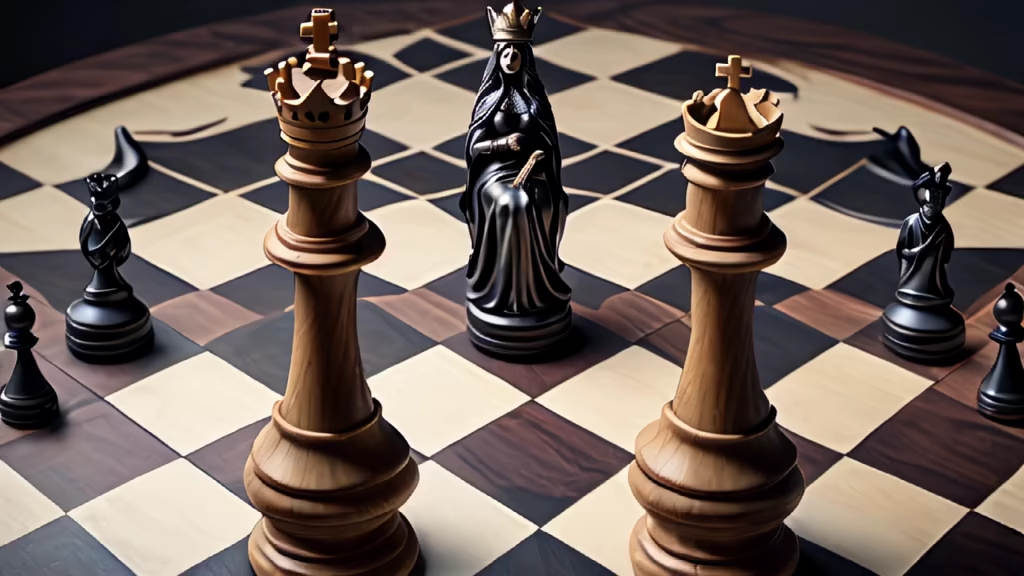
Prompt: \"Take a whimsical journey into a fantastical realm inspired by 'Alice in Wonderland.' Write about a curious character who stumbles upon a peculiar rabbit hole and finds themselves in a world filled with eccentric characters and surreal landscapes. Explore the bizarre encounters, unexpected challenges, and delightful curiosities that unfold as your protagonist navigates this peculiar Wonderland. Embrace the nonsensical and imaginative elements of Lewis Carroll's classic tale, and craft a story that captures the essence of wonder and adventure in this whimsical wonderland.\"
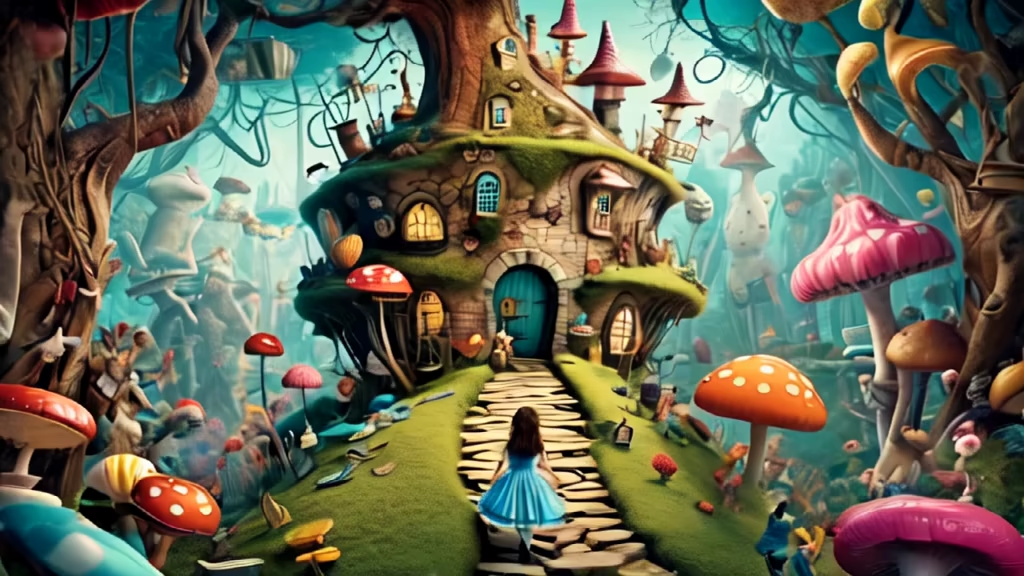
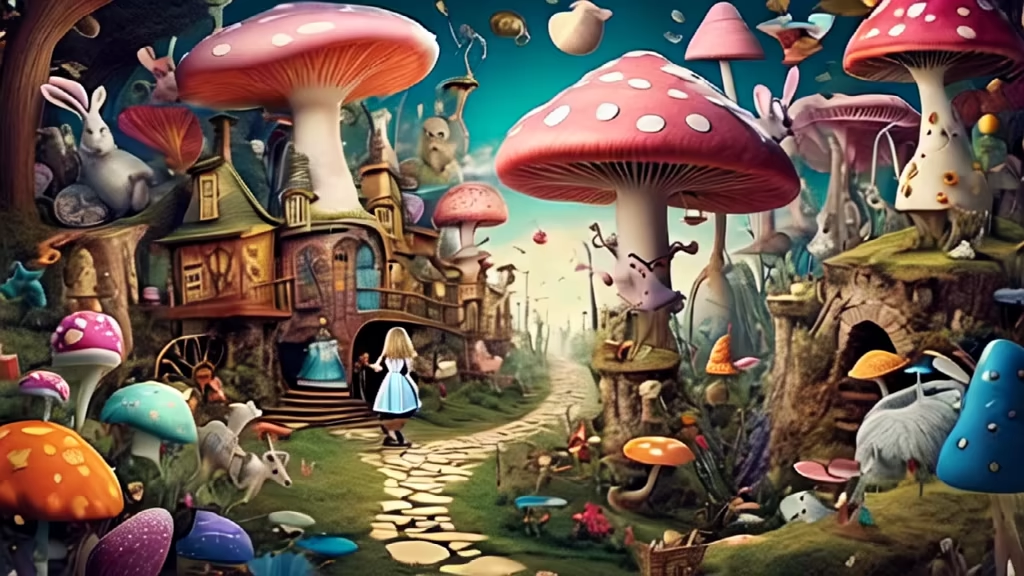
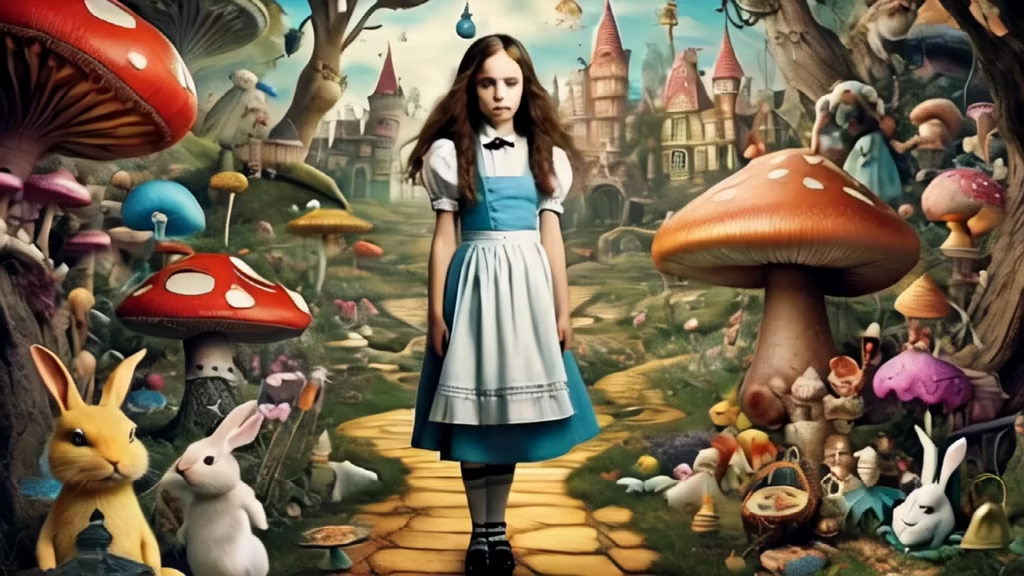
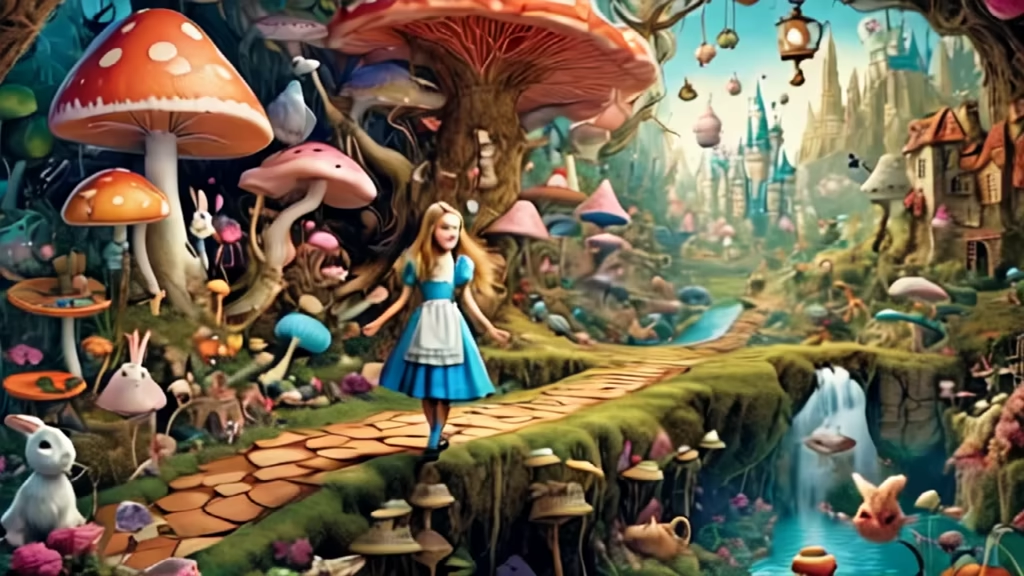
Prompt: The new scene with the Cheshire cat delights with its mystery.absolute photorealism.professional lighting delights Wow. directed by Tim Burton.
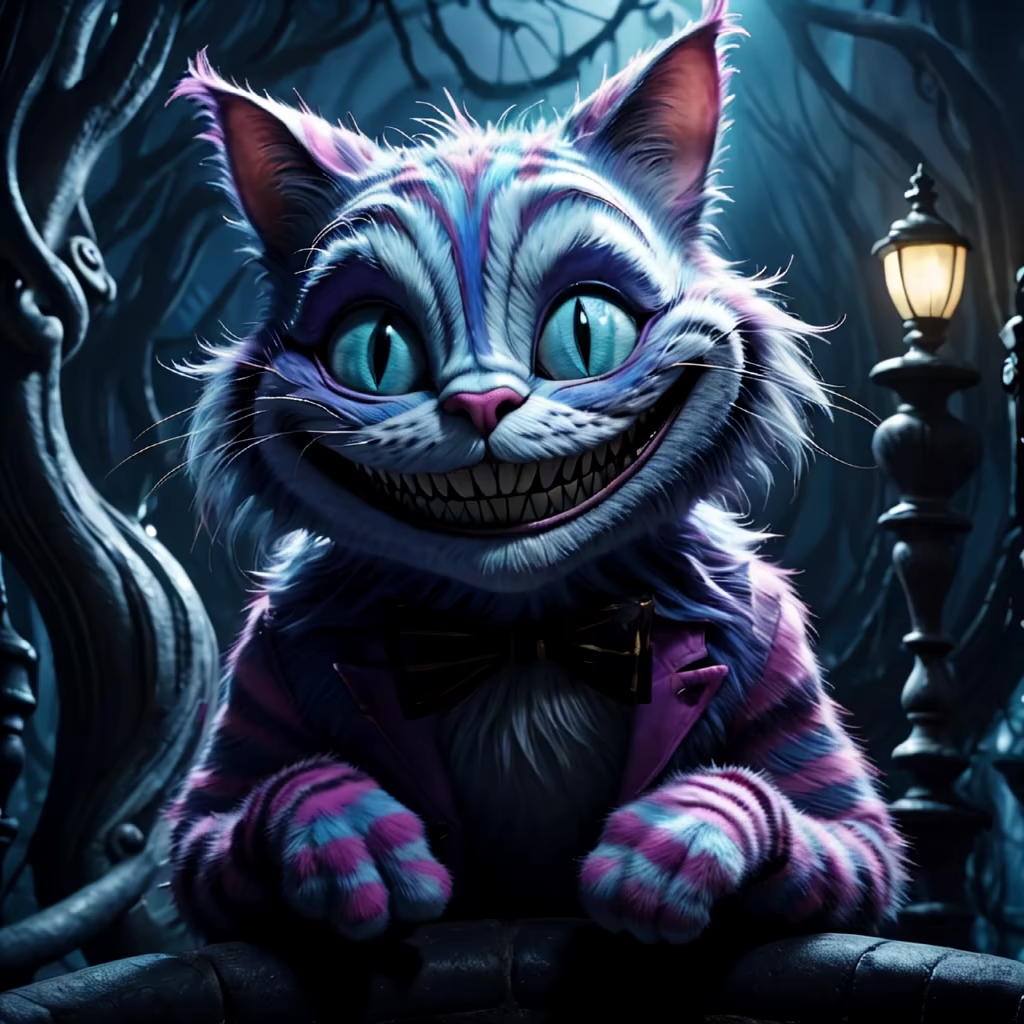


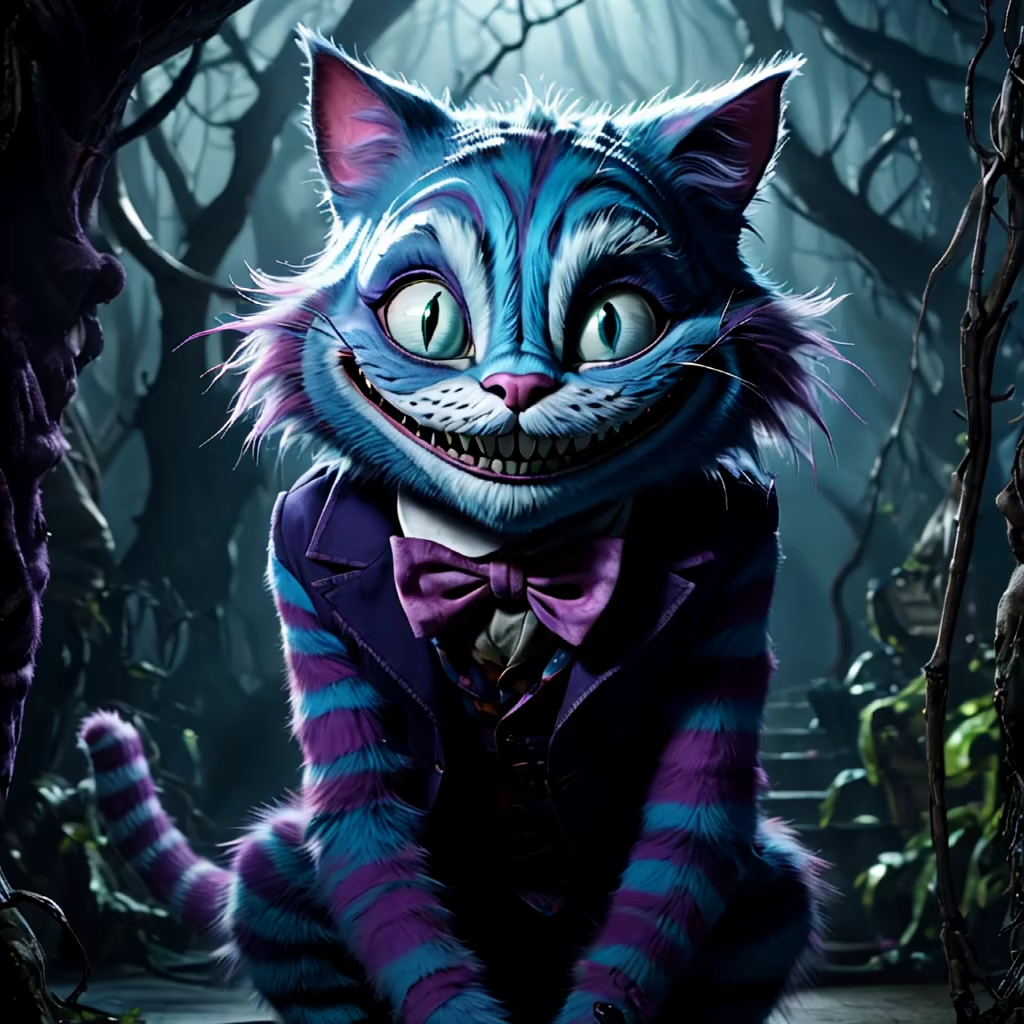
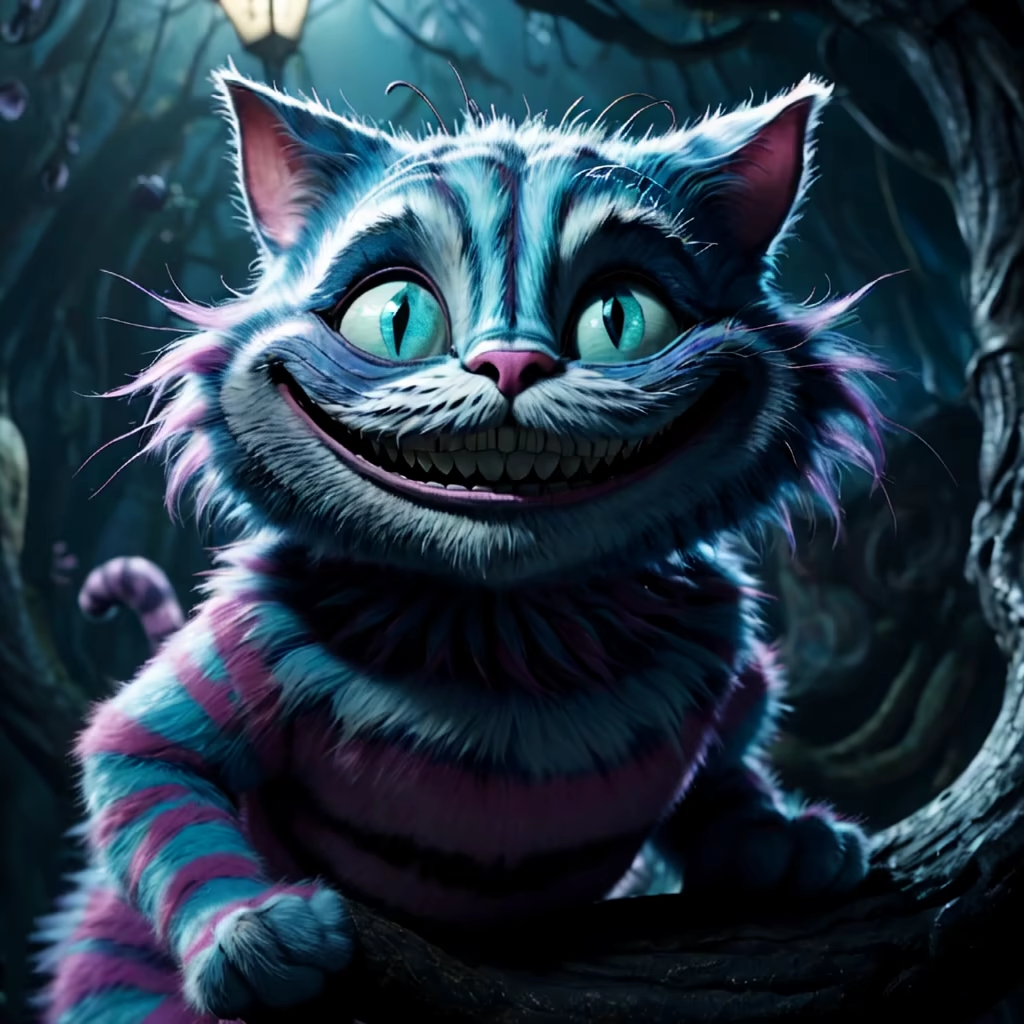
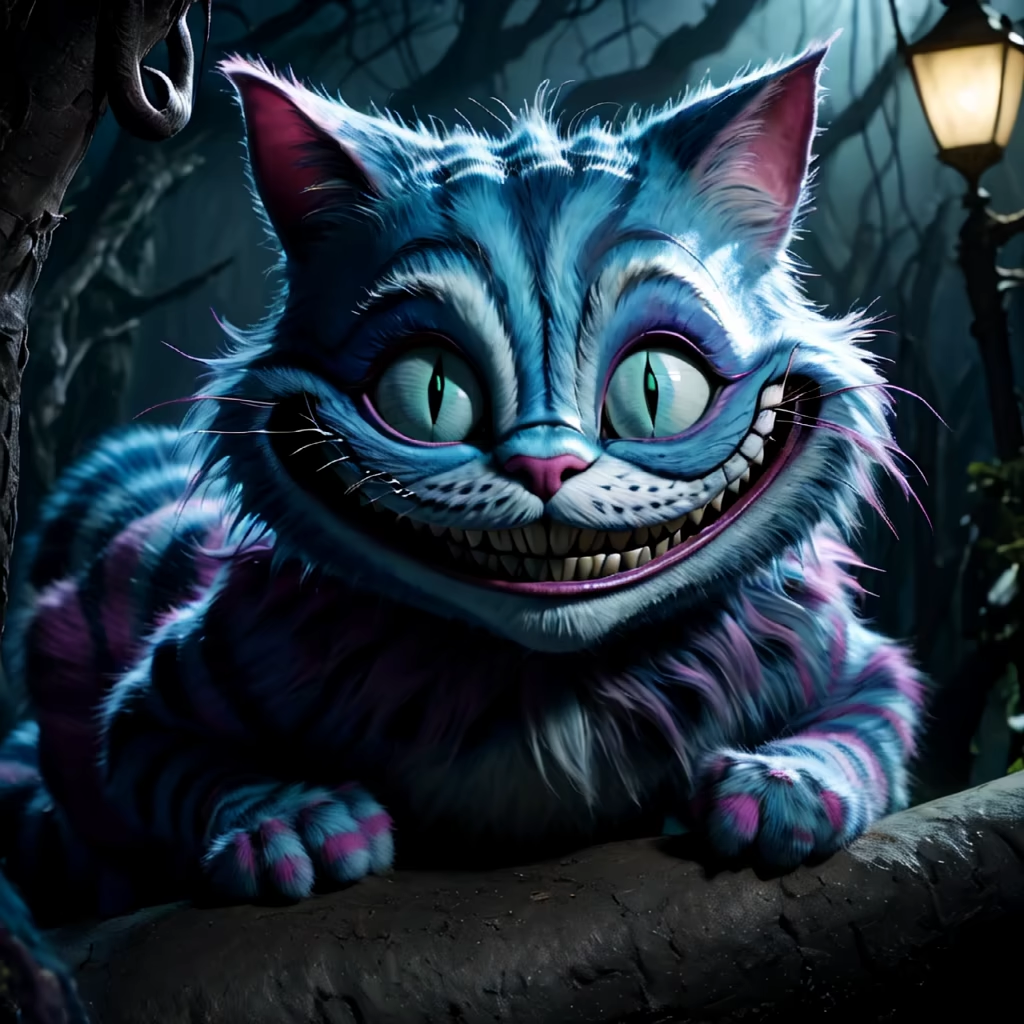
Prompt: The White Rabbit appears looking for the gloves and fan. Mistaking Alice for his maidservant, he orders her to go into his house and retrieve them. Alice finds another bottle and drinks from it, which causes her to grow to such an extent that she gets stuck in the house. Attempting to extract her, The White Rabbit and his neighbors eventually take to hurling pebbles that turn into small cakes. Alice eats one and shrinks herself, allowing her to flee into the forest.


Prompt: As time passed, Alice walked into another store and saw a strange man standing in the corner. His eyes emitted an evil light that made Alice feel uneasy. The man approached her and offered a mysterious item under extremely harsh conditions. Alice couldn't believe her ears. She firmly refused the deal, but the man didn't seem to be giving up.


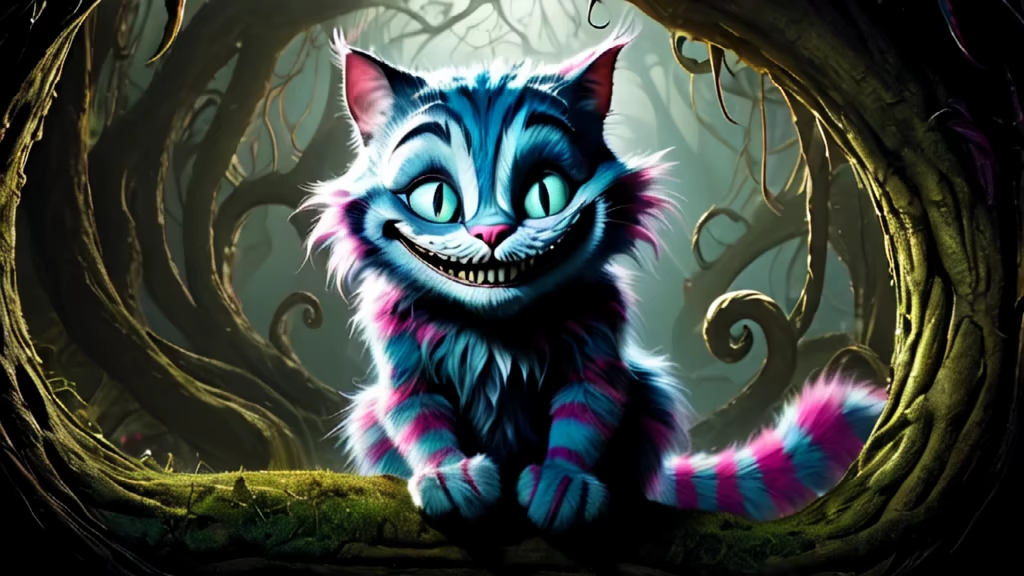
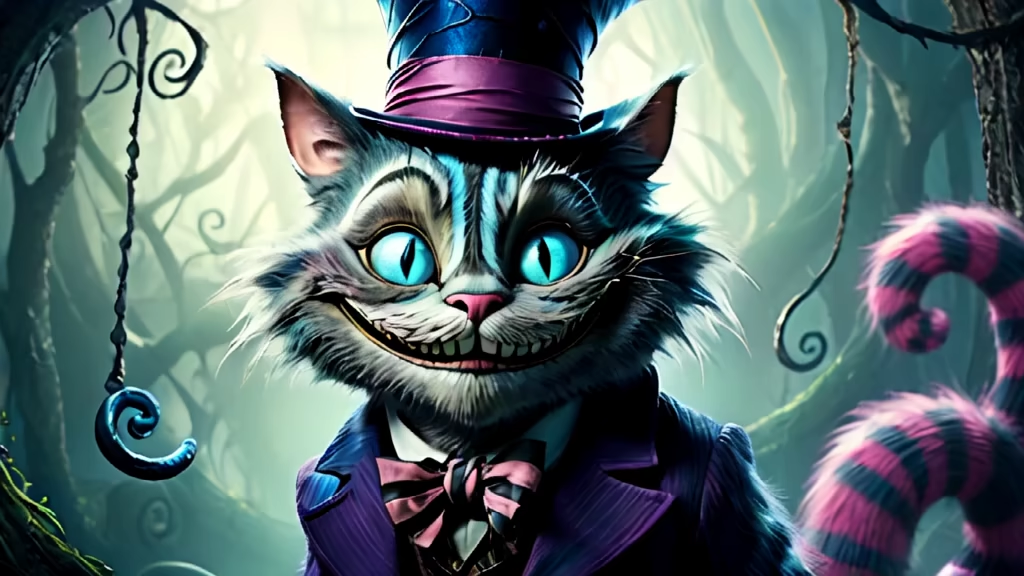


Prompt: anthropomorphic versions of the forces of life and death play a game of chess .
Negative: skull
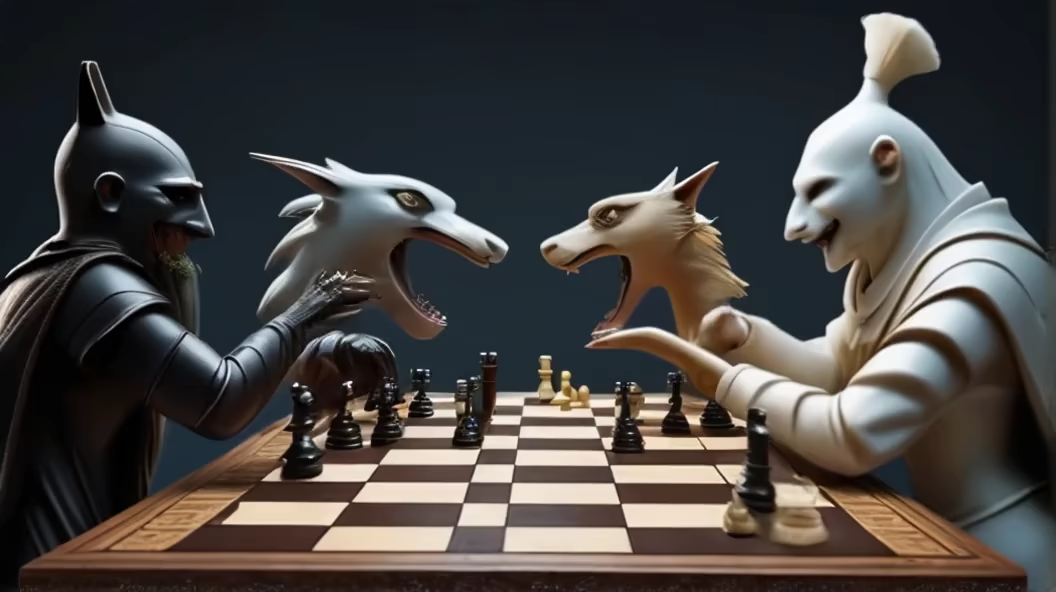
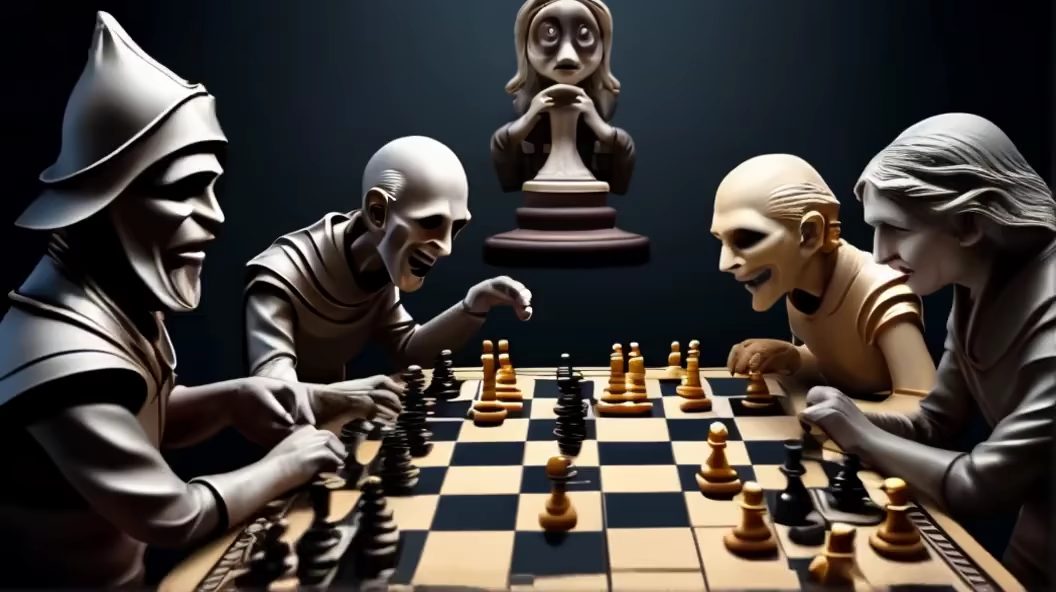
Prompt: anthropomorphic versions of the forces of life and death play a game of chess .
Negative: skull




Prompt: Alice The White Rabbit The Mouse The Dodo The Lory The Eaglet The Duck Pat Bill the Lizard Puppy The Caterpillar The Duchess The Cheshire Cat The Hatter The March Hare The Dormouse The Queen of Hearts The King of Hearts The Knave of Hearts The Gryphon The Mock Turtle
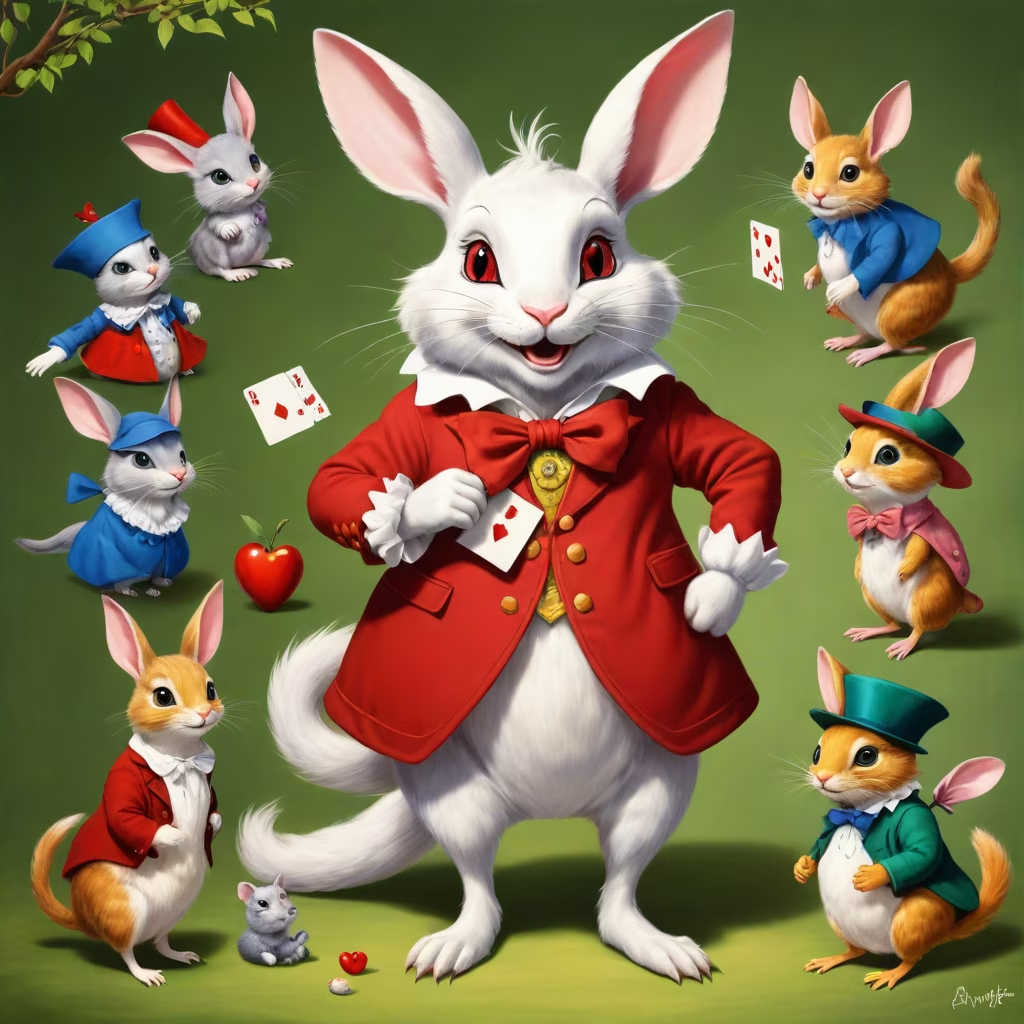















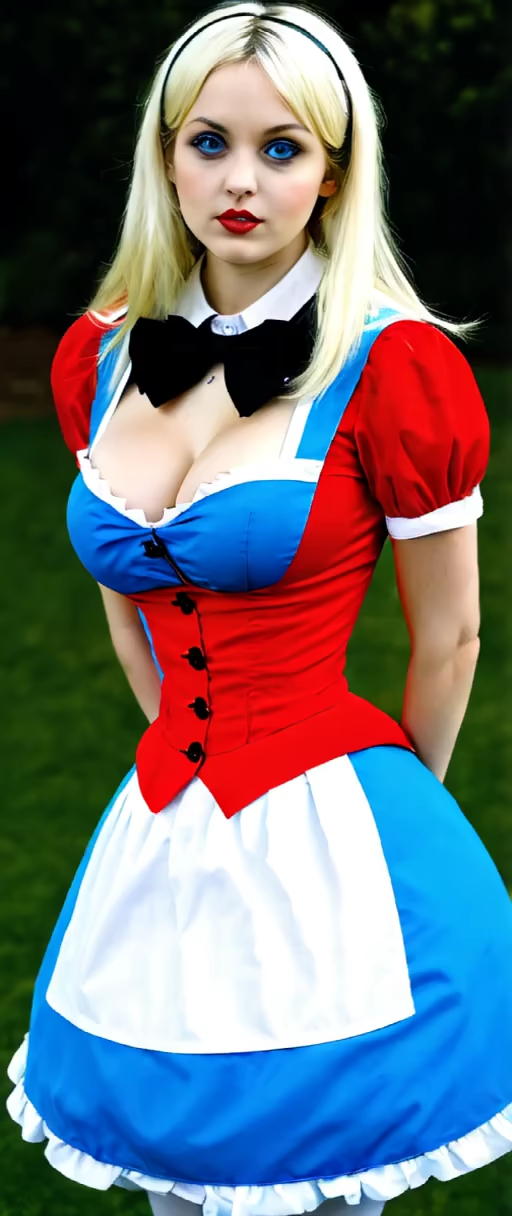
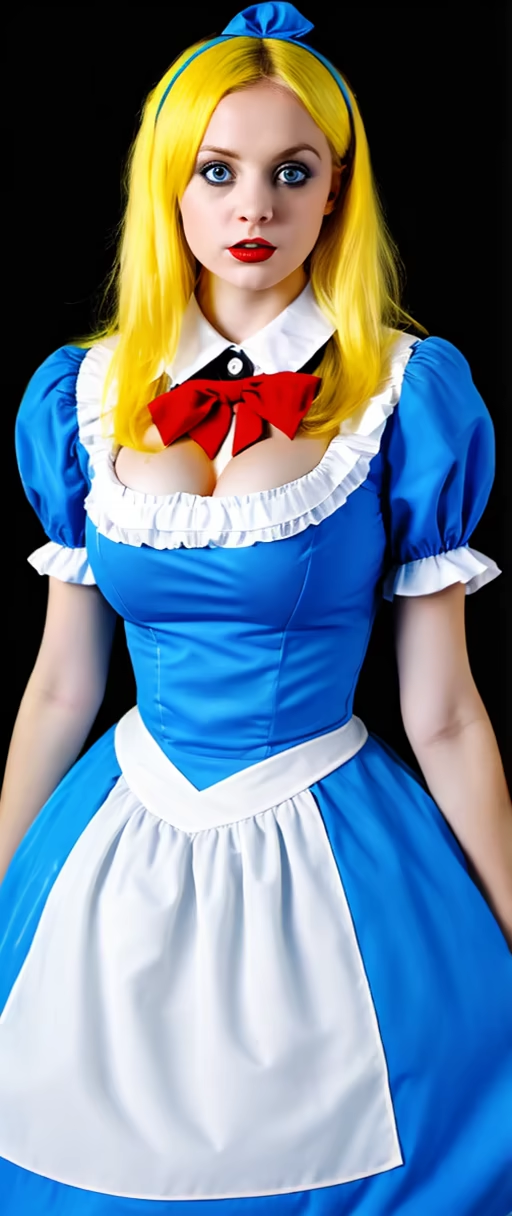
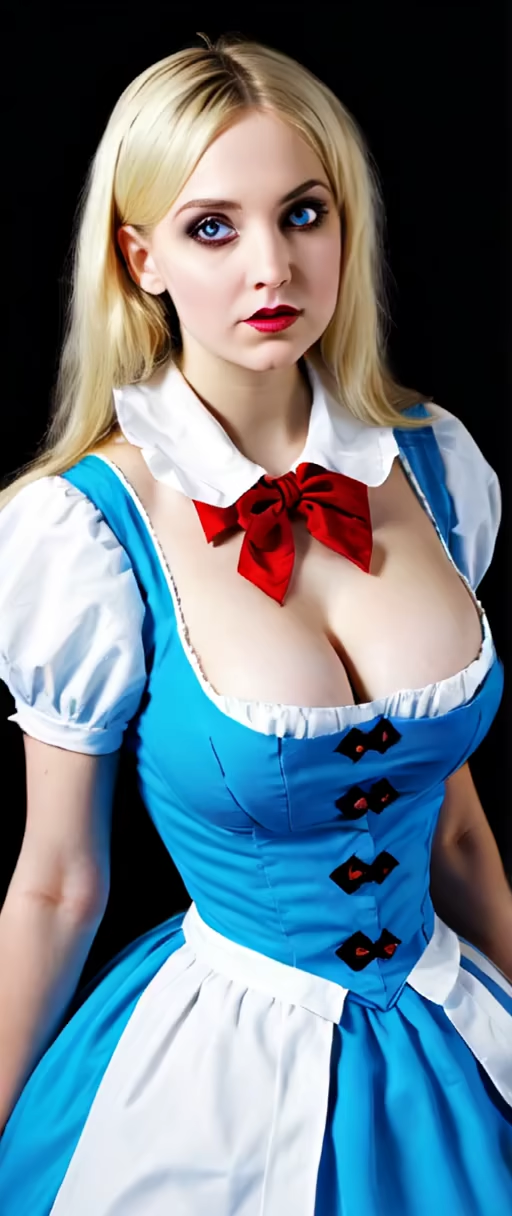
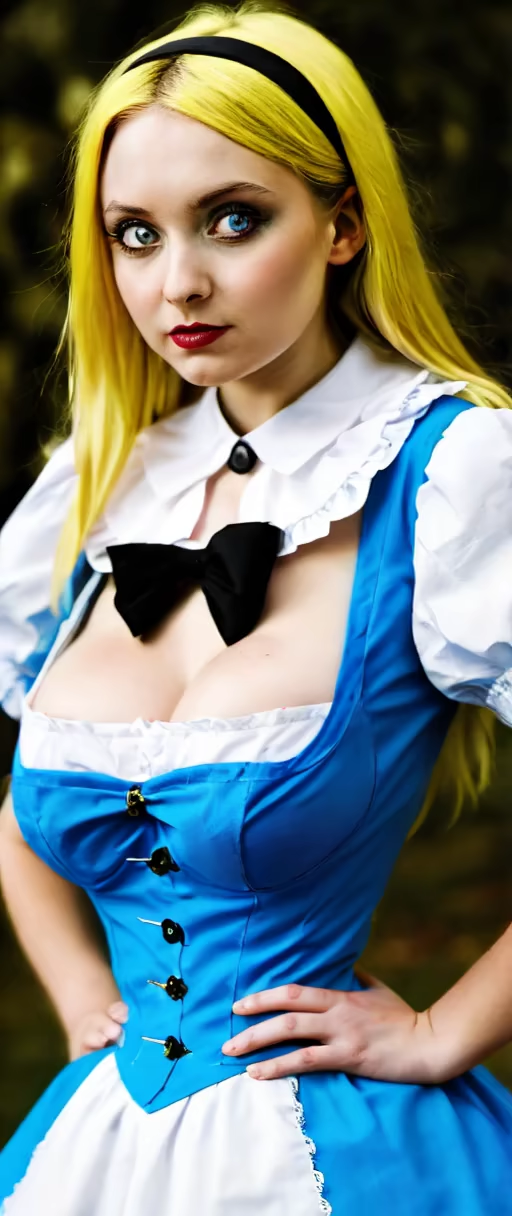
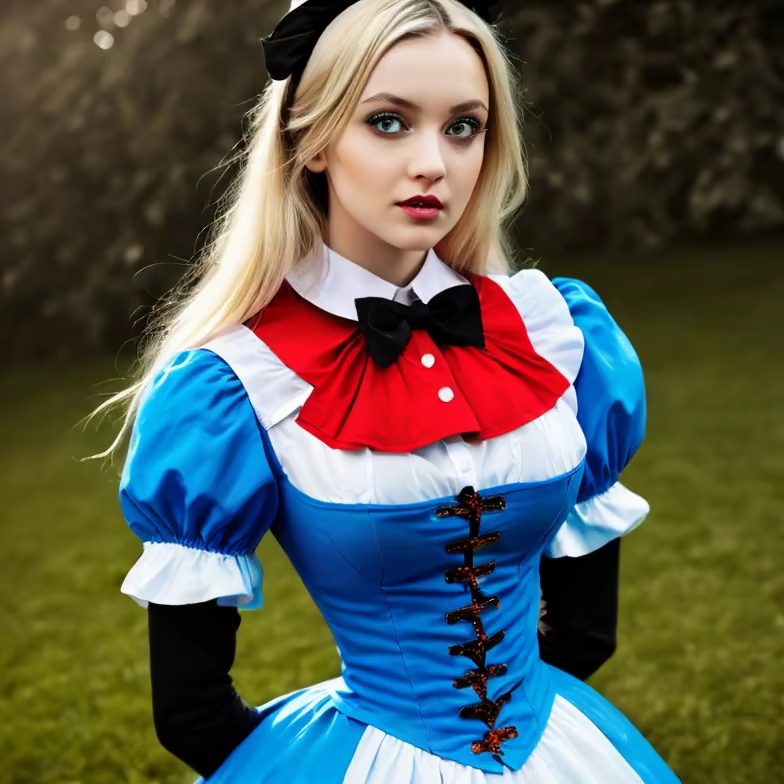
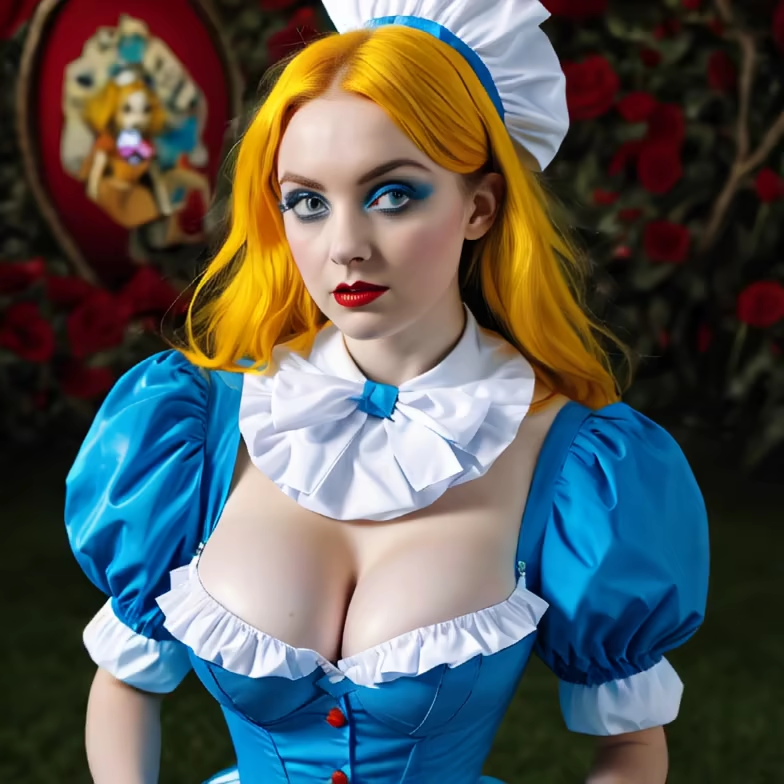
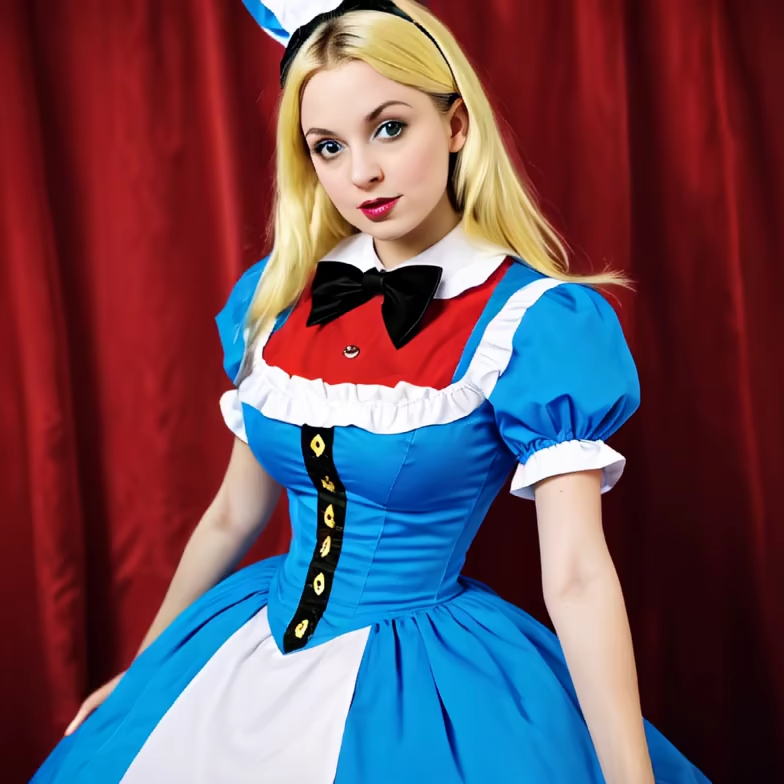


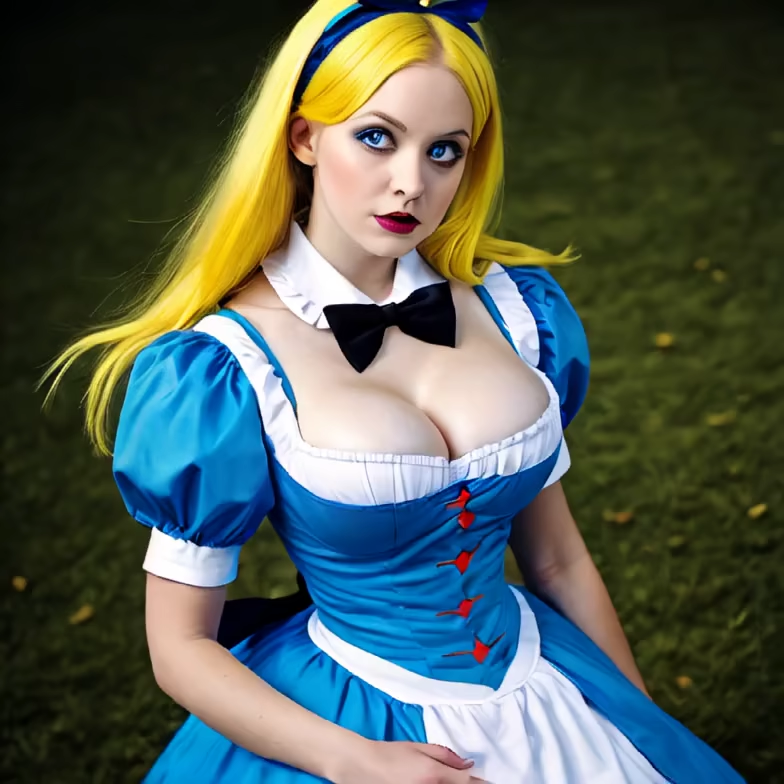
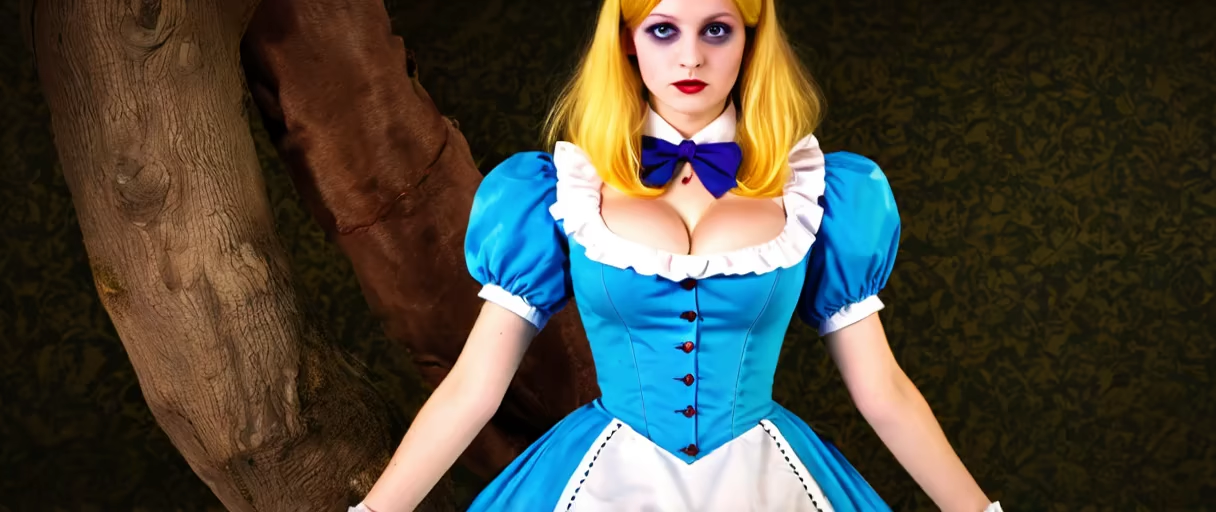
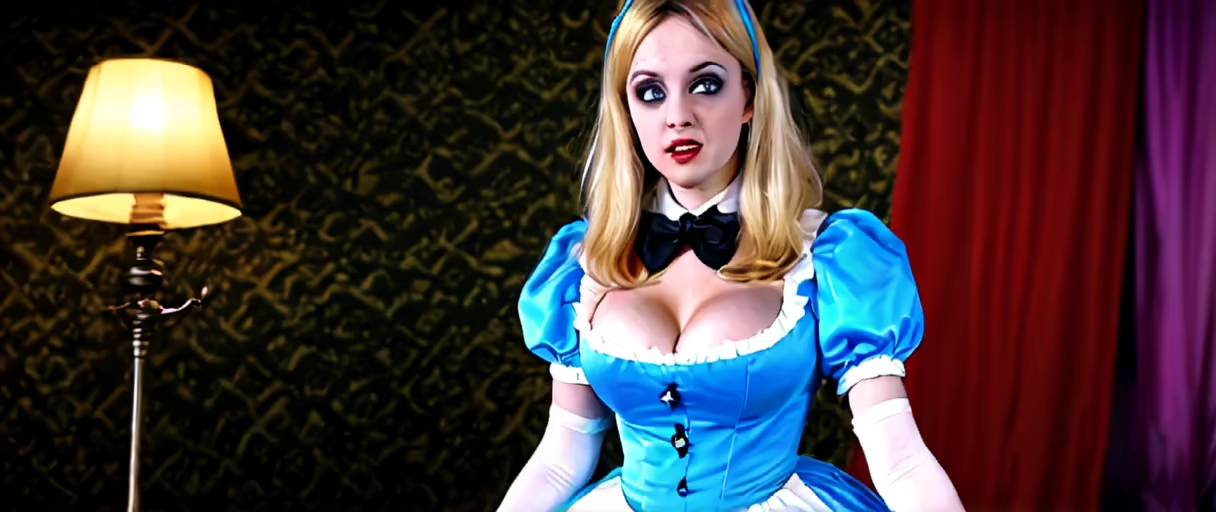
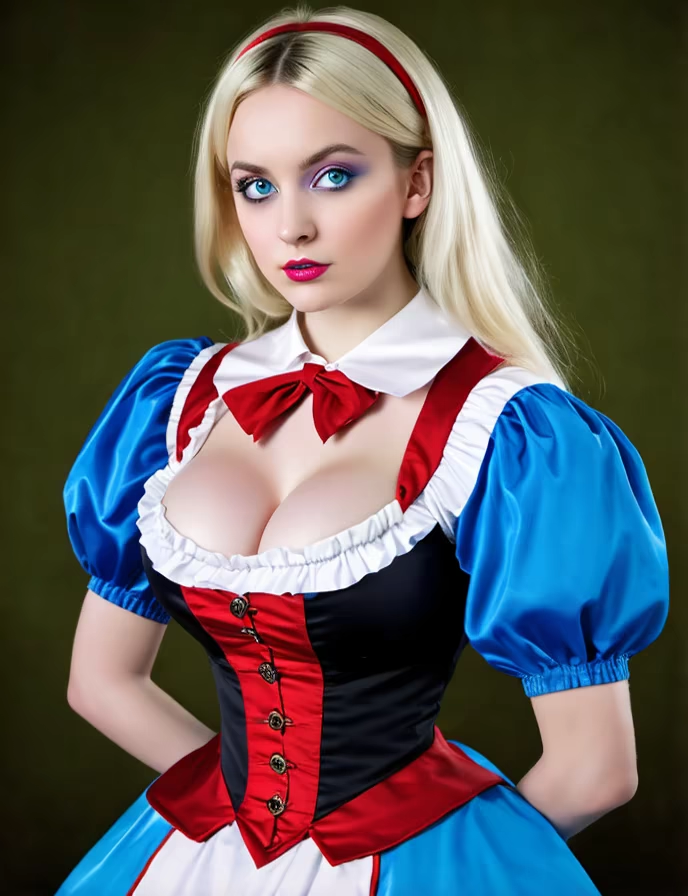
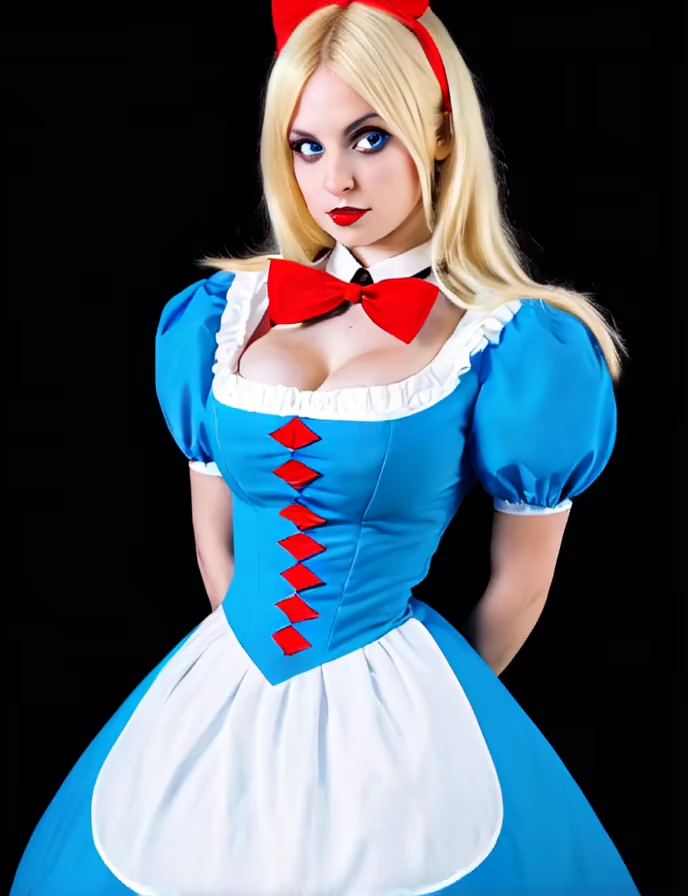


Prompt: Once upon a time, there was a little girl named Lily. Every Christmas, she eagerly awaited the arrival of Santa Claus, believing he would bring her surprising gifts. However, this year seemed a bit different. Lily's belief in Santa Claus was wavering; she began to doubt if Santa Claus truly existed. On Christmas Eve, Lily sat by the window, gazing at the starry sky. Suddenly, she heard a faint sound coming from the yard downstairs. Rushing down, she opened the door to find a chubby old man quietly placing a bag of gifts. Lily stared at him in astonishment, and as he turned, he revealed a familiar smile. \"Are you Lily?\" Santa Claus asked, smiling warmly. Lily nodded, filled with joy. He began recounting stories from Lily's childhood, surprising her with his knowledge of her life. \"I've been waiting for you!\" Lily exclaimed, moved. Santa Claus chuckled, \"Sometimes, we need to rediscover our beliefs within. Even if you can't always see me, my blessings and love are always there.\" That night, Santa Claus and Lily shared heartwarming moments, singing songs and sharing stories. Lily regained her belief in the magic of Santa Claus, understanding that even when unseen, belief in the heart remains the most important



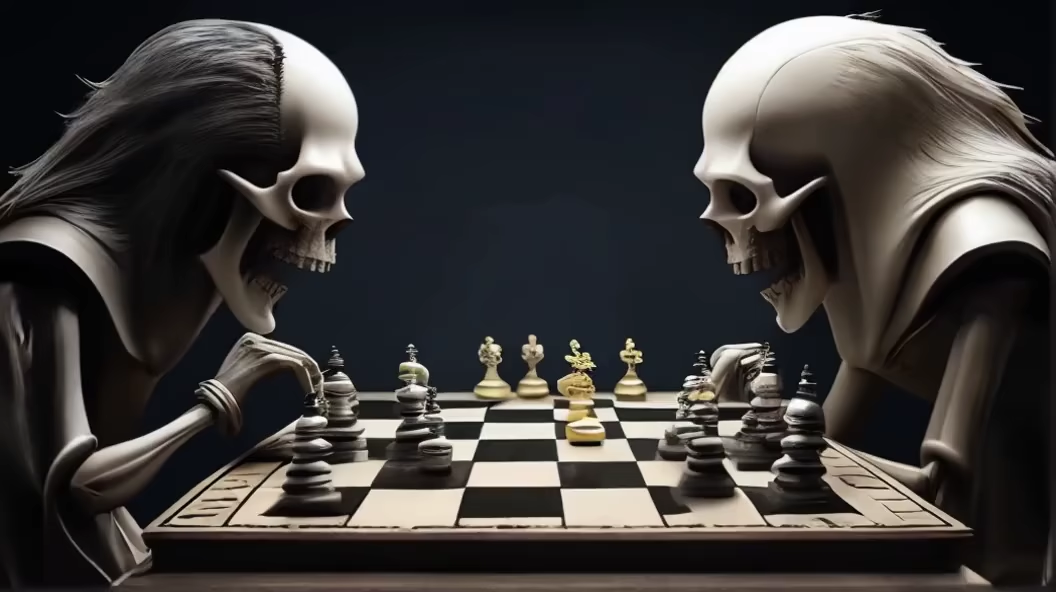
Prompt: Design a chess-inspired PATTERN that would work as a background for a childrens chess book.
Negative: chess board


Prompt: Create a stunning and mesmerizing artwork of chess piece bisop in the style of Absurdiest of the absurd, surrealist style, fantastical and a compelling atmosphere


Prompt: Once upon a time, there was a little girl named Lily. Every Christmas, she eagerly awaited the arrival of Santa Claus, believing he would bring her surprising gifts. However, this year seemed a bit different. Lily's belief in Santa Claus was wavering; she began to doubt if Santa Claus truly existed.




Prompt: https://media.discordapp.net/attachments/1180768296606388317/1191577239800791140/vincent-chase-vc-e12395-c2-eyeglasses_g_3155_1.jpg?ex=65a5f1c8\u0026is=65937cc8\u0026hm=680ed1a44583dc250059f60b396944c96c1c6194190fa8bef4e0c3a08dbdc4b5\u0026, diffrent view of this glass
Style: Photographic



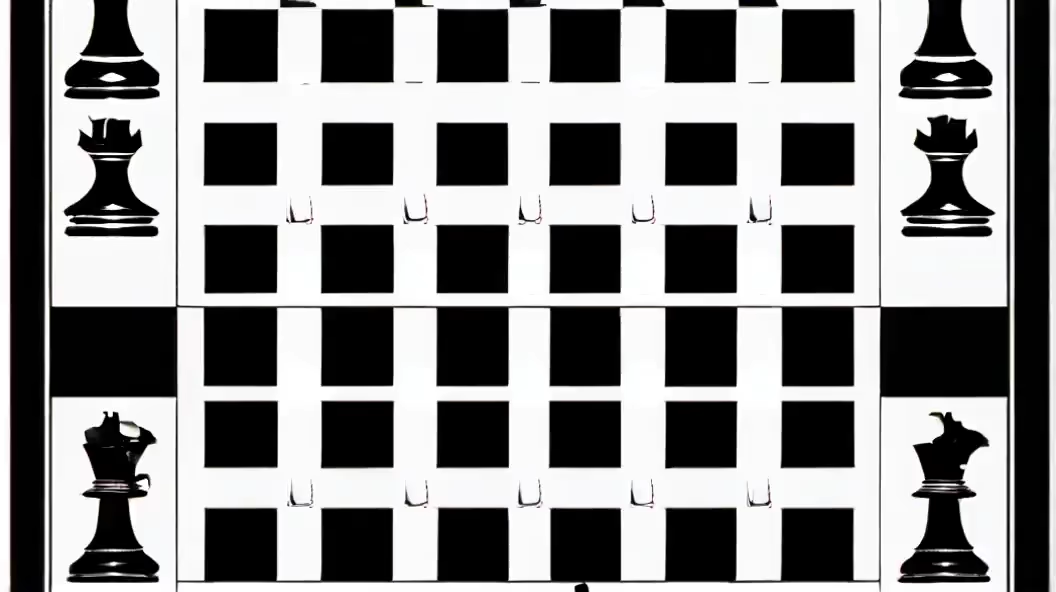
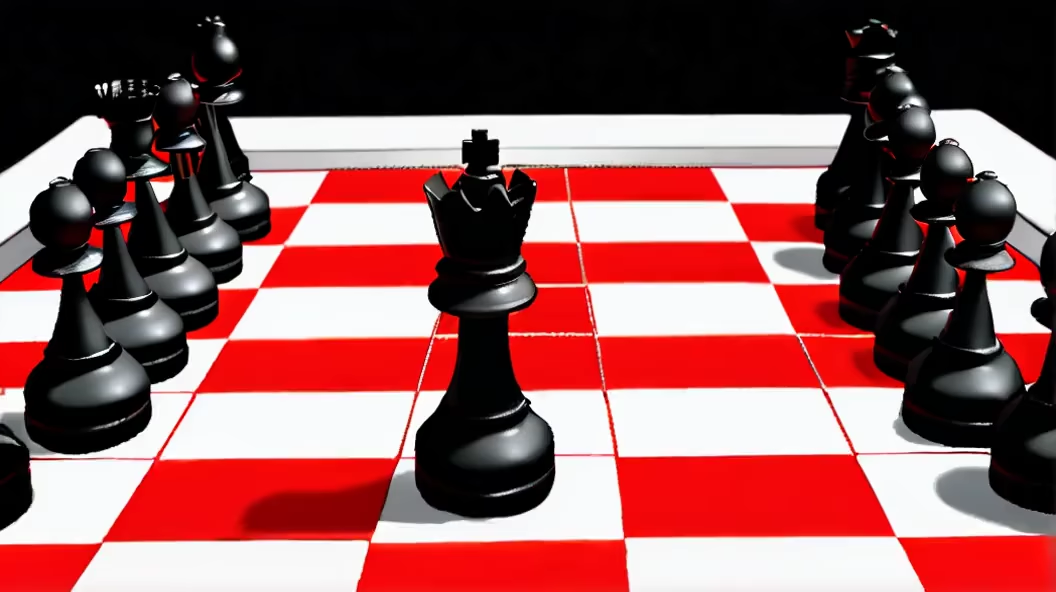
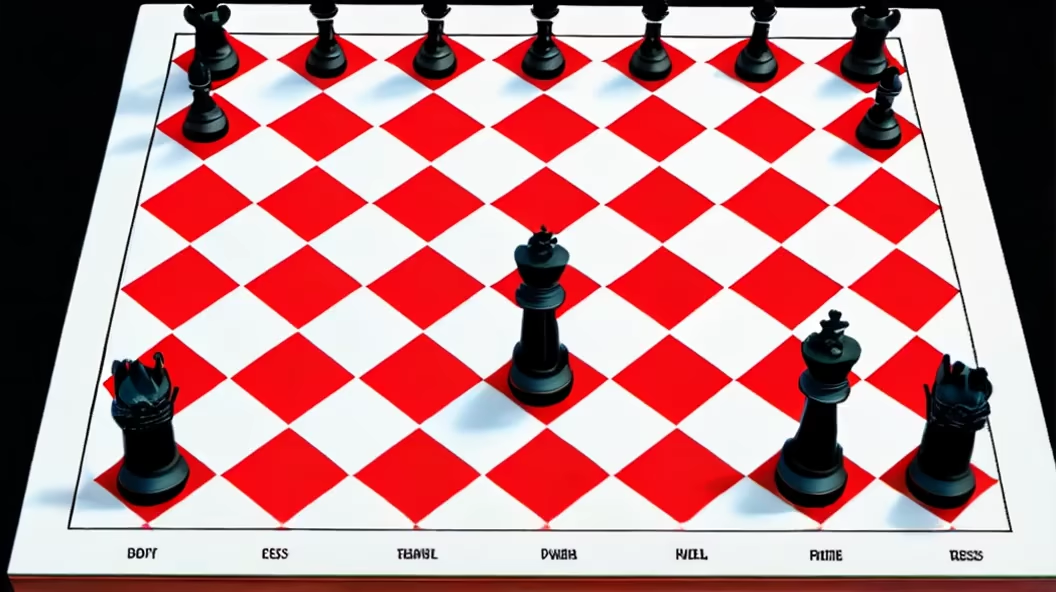
Prompt: Visualize a photograph of a chessboard with a single, strategically positioned piece standing at the center of attention. The board is meticulously arranged, and the piece represents a critical design choice. The atmosphere is tense, with shadows highlighting the importance of this decision. The image suggests that the entire game's fate hinges on this delicate balance, echoing the vulnerability of game design where even the smallest move can reverberate profoundly, leaving a lasting impact on the entire gaming experience.


Prompt: a chessboard where traditional chess pieces are replaced with human figures. Consider including elements that convey the personalities or characteristics associated with each chess piece in human form. The overall image should evoke a sense of hiearchy, encouraging viewers to interpret the strategic interactions between the humanized chess pieces.

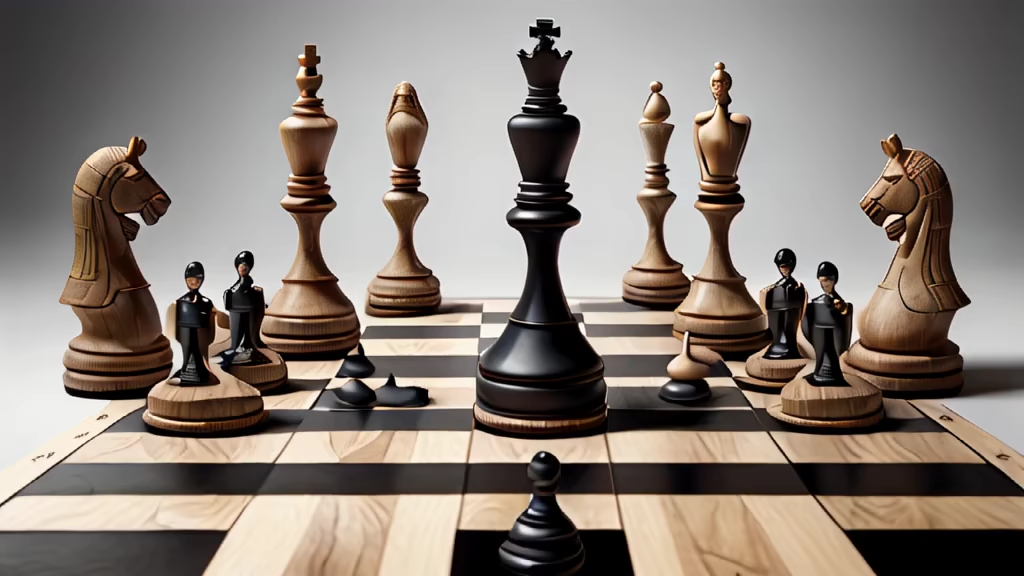
Prompt: of imaginative and vibrant illustrations for children's book about chess. The images should display a dynamic and enchanting chess theme, featuring a mix of chess pieces like rooks, bishops, knights, and pawns, creatively designed to capture a child's imagination. Add elements that convey a sense of discovery, strategy, and fun, suitable for a young audience. The design should be colorful and eye-catching, with space for the book title. Aim for a style that combines elements of adventure and learning, highlighting the joy and mental stimulation of chess in a way that's attractive and intriguing to children. Use a palette of bright, lively colors and engaging layouts to make the illustrations more appealing and memorable.


Prompt: cinematic, digital art, 2D illustration of a gravestone, rainy cloudy weather, grass with flowers, lighting strike, zombie hand reaching from the ground











